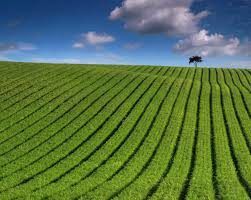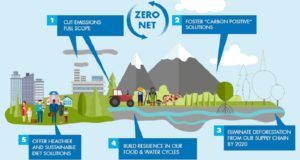Danone: Operating within the Tragedy of the Commons

How can Danone increase supply chain sustainability without becoming less profitable than its competitors?
Climate change is the ultimate Tragedy of the Commons. Companies and individuals acting in their self-interest are contributing to climate change, which is, in turn, threatening the survival of all. The food industry is a good example of this phenomenon, as it is particularly impacted by climate change, while being a major driver of greenhouse gas emissions. Danone, one of the world’s largest food companies best known for its dairy products, is facing the urgent challenge of making its supply chain more sustainable to be able to both slow down and withstand climate change, while continuing to remain profitable.
Climate change threatens Danone’s supply chain
Water supply: Danone relies heavily on water availability to sustain the pastures and livestock required to produce its dairy and plant-based products. However, rising temperatures are leading to water shortages around the world. In addition, as temperatures increase, livestock and pastures require more water to sustain themselves, which results in a magnified water shortage.[1]
Livestock behavior: Rising temperatures cause deviations in animals’ optimal temperature and deviations in excess of 4°F negatively impact milk production yields. [1]
CO2 concentration: Increased CO2 concentrations speed up the growth rates of plants; however, this results in smaller plants and reduced yields, because soil nutrient levels are not sufficient to match the accelerated growth rate. The resulting lower yields are also amplified by higher temperatures.[2]
These factors reduce supply chain reliability and could lead to significant raw material cost increases.
Optimizing the supply chain to curtail the impact of climate change
In the short term, Danone is preserving natural resources by increasing operational efficiency. Danone is on its way to reducing its own water use in factories by 60% in 2020 compared to the year 2000. The company is also reducing energy use across all offices and factories. [3] In addition, the company is increasingly relying on trains to ship product, instead of by road transport, to lower carbon emissions[4]. Danone has also taken a systematic approach to carbon emissions reduction by partnering with software company SAP to roll out a carbon calculation and management system that allows the company to measure carbon emissions for Danone’s 35,000 skus.[5] This data allows managers to make sustainable strategic decisions.
In the medium term, Danone is working with its farmers to develop water-efficient farming systems[6] and other sustainable practices, such as rotating crops and sustainable fertilizer management[7]. Additionally, Danone is striving to completely eliminate the use of paper from unsustainable sources, like deforested areas, by the year 2020.[8] Finally, the company is starting to roll out packaging made out of plant-based plastic, an approach that was developed through the Bioplastic Feedstock Alliance, a partnership with the WWF and other leading food and beverage companies.[9] [10]
Through these changes, Danone was able to reduce its carbon emissions as a percent of sales by 50% since 2007, and the company is on track to be carbon neutral in absolute terms by 2050.[11]
Figure 1: Danone’s plan for becoming carbon neutral
Resolving the Prisoner’s Dilemma through increased regulations and partnerships across the food industry
While Danone has already made significant changes to its supply chain, the company is still contributing to climate change, as it will not be carbon neutral until 2050. However, setting more aggressive targets would likely cause a drastic increase in raw material costs threatening the firm’s profitability. There is a limit to customers’ willingness to pay for “green” products, and poorer consumers would no longer be able to afford Danone’s “better for you” products. Furthermore, the farmers that provide Danone with raw materials would have to bear a share of these cost increases. This would make it more difficult for them to make a living. Additionally, if Danone is the only large food company that takes more aggressive goals, most price-sensitive consumers would shift to competitors. To avoid this “Prisoner’s Dilemma”, Danone should lobby in favor of more stringent carbon regulations within the food industry. Indeed, coordinated collective government responses have proved more effective in tackling climate change than the private sector.[13] Additionally, Danone should work closely with other large food companies to develop a set of common sustainable practices that could be recognized by the customer through a “green label.” Danone has already engaged in this type of work within the Bioplastic Feedstock Alliance, but I believe this sharing of best practices should expand to these companies’ agricultural supply chain. Finally, Danone could consider profit sharing initiatives with its farming partners to ensure that incentives are aligned across the supply chain and that the required changes are sustainable for all entities involved. Full vertical integration with farmers could also potentially help Danone better adapt its supply chain to climate change, but could this idea have negative implications?
[791 words]
[1] National Climate Assessment, US Global Change Research Program, 2014, nca2014.globalchange.gov/report/sectors/agriculture#statement-16364.
[2] Climate Impacts on Agriculture and Food Supply.” EPA, Environmental Protection Agency, 6 Oct. 2016, 19january2017snapshot.epa.gov/climate-impacts/climate-impacts-agriculture-and-food-supply_.html#ref1.
[3] Water. Danone, www.danone.com/en/for-all/sustainability/better-world/water/.
[4] Danone. “Less CO2 for Every Tonne of H20 – Danone – Medium.” Medium, Medium, 2 Feb. 2017, medium.com/@Danone/less-co2-for-every-tonne-of-h20-e617bfe4303f.
[5] Danone and SAP Team Up to Analyze and Measure Carbon Footprint Across 35,000 Products .” News.sap.com, SAP, 2012, news.sap.com/danone-and-sap-team-up-to-analyze-and-measure-carbon-footprint-across-35000-products/.
[6] Water. Danone, www.danone.com/en/for-all/sustainability/better-world/water/.
[7] “Dannon Announces Breakthrough Sweeping Commitment for Sustainable Agriculture, More Natural Ingredients and Greater Transparency.” Dannon.com, 29 Aug. 2016, www.dannon.com/the-dannon-pledge-on-sustainable-agriculture-naturality-and-transparency/.
[8] Packaging. Danone, www.danone.com/en/for-all/sustainability/better-world/packaging/.
[9] “Danone Uses Bioplastics for Yogurt Packaging.” Food Packaging Forum, www.foodpackagingforum.org/news/danone-uses-bioplastics-for-yogurt-packaging.
[10] “Danone Is Part of the Bioplastic Feedstock Alliance.” Down To Earth, downtoearth.danone.com/2013/11/20/danone-is-part-of-the-bioplastic-feedstock-alliance/.
[11] Climate. Danone, www.danone.com/en/for-all/sustainability/better-world/climate/.
[12] Climate, Danone, www.danone.com/en/for-all/sustainability/better-world/climate/.
[13] Stavins, Robert. “The Problem of the Commons: Still Unsettled after 100 Years” American Economic Review, February 2011, 81-108




Great post! I agree with your assessment of the prisoner’s dilemma as a motivating factor to lobby for stricter regulation. However, I also think Danone may also benefit from taking action sooner than its competitors to shore up its supply chain in response to climate change. Similar to the issues from the IKEA case, there may be higher prices in the short-term, but Danone has to also consider the long-term price implications of climate change given its scale. Responding earlier than its competitors may ultimately end up being a competitive advantage. If Danone integrates vertically into farming (similar to how IKEA ended up purchasing forests) and sets high sustainability standards for itself, I think it may be in a better position to maintain lower prices in the long run.
Interesting post, EMC!
As a fan and consumer of Danone, I was happy to learn more about the company and the challenges that it faces. I too wrote about climate change, and learned about the serious implications that it could have on business and supply chain management.
You highlight the direct effect that climate change has on water supply, livestock behavior (who would have known!) and CO2 concentration, and the things that Danone is already doing to deal with these challenges. I am concerned with the time frame of some of the suggested changes, reducing water supply by 60% in the next 3 years and completely eliminating paper from some deforested areas by 2020 seems like a tough task for Danone to complete, although it might very well be achievable.
You correctly highlight that customers are price sensitive after a certain point, and they will simply switch to other products that offer more competitive prices. I wonder whether the industry will follow or suffer from the tragedy of the commons and continue to deteriorate the environment that feeds them.
In your long term plan, you mention lobbying for change with governments, although I wonder how effective that could be unless it is industry-wide. Through my own research for this assignment, I learned that capping carbon emission not do much for the CO2 that has already been released into the environment, and it would take close to 80 years if the world stopped producing CO2 tomorrow to see 0.001% improvement. It might be better for them to use their resources elsewhere and think about different farming practices or partnerships with farmers as you suggest rather than fighting difficult government for a change that might not lead to much improvement for the environment. To your point about farmers, what I do know is that they have incredibly strong lobby groups and their own incentives to remain non-integrated with larger corporations like Danone, because Danone might start squeezing them after a couple of years. I don’t see Danone fully integrating with famers in the future.
It’s so interesting to think about Danone’s dilemma as a dairy company in the context of 1) corporate responsibility to be sustainable, but also 2) needing to be sustainable in order to maintain their profits, and finally 3) being a major contributor to climate change as a dairy company emitting greenhouse gases (by way of cows and their manure). I think you characterized the problem very well, and your solution of lobbying for governmental regulation seems to be the most effective to get every player on the same page, and avoid taking on the sustainability burden all for themselves.
Another point that I find salient is the impact of climate change on safety and health of the dairy product. A research report done on the dairy industry in Ireland identified a number of food safety risks involving contaminants and natural toxins (i.e., increase of range of mycotoxins) given that the general climate is projected to be warmer. Similarly, the cows producing the dairy products may be affected by diseases associated with climate change, and could cause new veterinary medicines to enter into their milk. That I think will be another complicating factor that Danon will need to be aware of.
Reference: http://www.safefood.eu/Publications/Research-reports/The-impact-of-climate-change-on-dairy-production.aspx
I strongly believe that in order to make any progress on sustainability, it is critical that the actions that a brand takes also helps it to do business. You are absolutely right in the assessment that if they take a big leap and if the competition does not move with them, then they can get “priced out” fairly quickly – given the dairy industry is crowded and people are not too brand loyal. Working with the regulators is a good idea. Another thing that I was thinking was to use this as a marketing story as well. While some people might feel that it is taking advantage of a sincere issue, but it is only when the company starts seeing the benefit of their sustainability actions does it become the norm for the company. This move can also force competitors to take steps in the right direction which will be better for Danone and the world.
A fascinating post!
I agree that incumbent companies can derive value by lobbying for greater environmental sustainability standards, which raises the costs of production for everyone in the industry and raises barriers to entry. Maersk, the world’s leader in shipping, has adopted this as a competitive strategy in some markets. [1]
In addition, I support your initiative for Danone to actively cooperate with their smaller suppliers. A different post (Nikhil’s) discussed how Starbucks is experimenting and developing more heat and pest-resistant strains of coffee plants to face the changing current conditions. I do not see why Danone could not engage in a similar program. [2]
[1] http://www.presstelegram.com/2016/11/07/maersk-deal-to-reduce-emissions-a-quantum-leap-in-environmental-progress-port-officials-say/
[2] http://www.ticotimes.net/2017/01/26/starbucks-coffee-costa-rica
Great article!
I agree that working closer with other corporations is the key to taking on the challenge of reducing climate change’s effects on Danone’s business.
Vertically integrating with farmers presents a whole range of new challenges, however. First, there are anti-trust issues to take into account, that may prevent this integration from being simple to implement. And second, integrating with farmers will inevitably lead to squeezing them even further, in search for more value across the value chain, and could ultimately take away their livelihoods.
I’ll be very interested to see how this plays out!